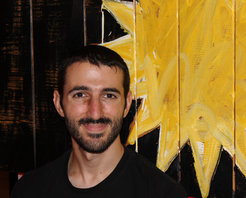Reconstructing the Sun’s Past from Historic Photographs
Using historical data, MPS researcher Dr. Theodosios Chatzistergos looks back into our star’s past. He has now received a prestigious award in recognition of his work.
The Scientific Committee on Solar-Terrestrial Physics (SCOSTEP), a panel of the International Science Council (ICS), has honored Dr. Theodosios Chatzistergos of the Max Planck Institute for Solar System Research (MPS) with this year's Distinguished Young Scientist Award. With this award, the Committee recognizes the young researcher's contributions to the reconstruction of past solar activity and variability. Among other things, Dr. Chatzistergos has succeeded in making more than 100 years of historical observations of so-called faculae, particularly bright regions on the Sun, serviceable for this purpose. Chatzistergos' results help to understand how strongly the Sun’s activity and brightness varied in the past - and whether this influenced the climate on Earth.

Understanding the Sun's influence on Earth's climate requires more than a snapshot. Rather, it is necessary to look back as far as possible ? both at climate changes that occurred on Earth and at the ever-changing activity of the Sun. However, research into the history of the Sun is difficult. The crucial variable, the intensity of solar radiation arriving at the top of Earth's atmosphere, can only be measured by satellites since 1978.
Fortunately, variations in solar activity manifest themselves in many ways. Changes in solar irradiance are mainly due to the constantly emerging and disappearing dark and bright regions, called sunspots and faculae, on the Sun’s visible surface. Driven by the Sun’s dynamic magnetic field, both phenomena occur frequently while the Sun’s activity is high; during periods of low activity, they are much less abundant. Sunspots are visible from Earth with simple optical instruments; astronomers have been recording their number almost continuously since 1609. Faculae, on the other hand, are more difficult to grasp. To consider their influence on solar irradiance variations in detail and over as long a period as possible is the scope of Dr. Theodosios Chatzistergos' work.
Interplay of sunspots and faculae
Sunspots and faculae often appear in close temporal and spatial proximity. In previous calculations, therefore, it was often assumed that the number and area of faculae could be inferred from historical records of sunspots. "However, sunspots and faculae are not perfectly in sync," Chatzistergos cautions. Much more precise information on faculae is provided by images of the Sun obtained by using only violet light of a special wavelength. It is emitted by ionized calcium ions in the particularly hot regions above the faculae. Measurements of this kind have existed since 1892, but not consistently from one and the same observatory.

Chatzistergos has succeeded in combining the various faculae data sets from almost all parts of the world - thus making them accessible for the first time as a long-term archive of solar activity. The result is a treasure trove of data that maps the behavior of the Sun over the entire 20th century. From data of this kind, it is possible to calculate the magnetic fields on the solar surface and, from these, the irradiance variations of the Sun. As the researcher has already been able to show, for the past decades these calculations agree well with the irradiance variations measured from space.
Dr. Theodosios Chatzistergos studied Astronomy and Astrophysics at the National and Kapodistrian University in Athens, Greece, and at Queen Mary University in London, England, where he focused on Saturn's moons and rings in his thesis. During his PhD at MPS, which he completed in 2017, he turned his attention to the Sun and specifically to the reconstruction of its historical brightness variations. After a two-year research stay at INAF Osservatorio Astronomico die Roma, Italy, Dr. Chatzistergos has been continuing his career at MPS since mid-2020.
The Scientific Committee on Solar-Terrestrial Physics (SCOSTEP) is a panel of the International Council for Science (ICS), the world's largest umbrella organization of national and international science associations. SCOSTEP brings together scientists from a wide range of disciplines who study the relationship between the Sun and Earth. Every two years, the committee presents the SCOSTEP Distinguished Young Scientist Award to a young scientist for significant contributions to this field of research.

